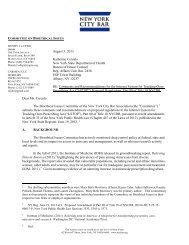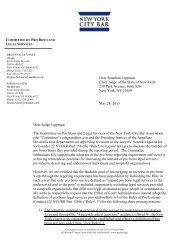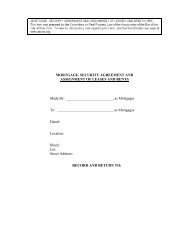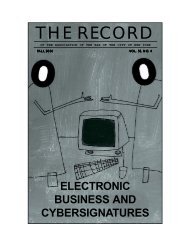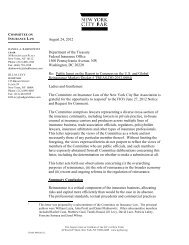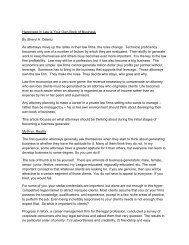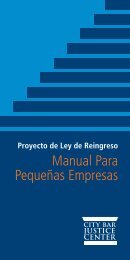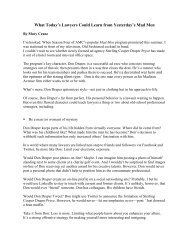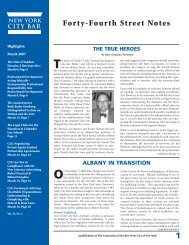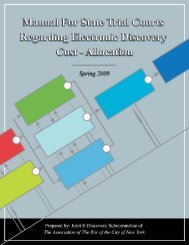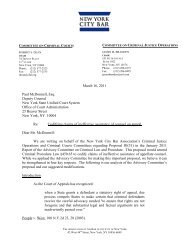2007 Issue 1 - New York City Bar Association
2007 Issue 1 - New York City Bar Association
2007 Issue 1 - New York City Bar Association
You also want an ePaper? Increase the reach of your titles
YUMPU automatically turns print PDFs into web optimized ePapers that Google loves.
F O R M A L O P I N I O N 2 0 0 7 - 1<br />
that such communications are “ethically risky” under the <strong>New</strong> <strong>York</strong> Code<br />
of Professional Responsibility and that the question should be decided<br />
on a case-by-case basis, upon consideration of a number of highly factspecific<br />
questions. ROY SIMON, SIMON’S NEW YORK CODE OF PROFESSIONAL RESPON-<br />
SIBILITY ANNOTATED 1057-58 (2006 ed.). 3<br />
The Rule should be interpreted in accordance with its purposes. Although<br />
in-house counsel may well be among the category of decisionmakers<br />
within the organization with whom contact would be prohibited<br />
under even a relatively narrow version of the rule, see Niesig, 558 N.E.2d at<br />
1031 n.1, the fact that such counsel are trained in the law and often<br />
assigned to represent an organization places them in a different position<br />
than a non-lawyer employee—a distinction that Niesig did not need to,<br />
and did not, address. The principal purposes of the Rule are to prevent a<br />
lawyer from taking advantage of a non-lawyer who is represented by counsel<br />
(for example, in eliciting damaging admissions or agreement to unfair<br />
settlement terms) and to preserve the attorney-client relationship once it<br />
has been established. See, e.g., Tylena M., 2004 WL 1252945, at *1; In re<br />
Grievance Proceeding, 2002 WL 31106389 at *2-3. These purposes are at best<br />
attenuated when the recipient of the communication is a lawyer, and is<br />
acting as such. It fairly may be presumed that an in-house counsel, trained<br />
in the law, can exercise judgment as to whether he or she should engage<br />
in a given communication. Moreover, in most cases it should be a simple<br />
matter for in-house counsel to refuse to engage in such a communication<br />
and refer the caller to outside counsel. If the in-house counsel chooses to<br />
engage in the communication, the risk of making damaging admissions<br />
or entering into prejudicial agreements would seem to be no greater than<br />
with any other lawyer-to-lawyer communication.<br />
3. Professor Simon lists eleven “factors that may be relevant”: (1) size of the corporation<br />
whose in-house counsel is to be contacted; (2) size of its legal department; (3) degree of<br />
experience of the in-house counsel with the type of litigation involved; (4) degree to which the<br />
in-house lawyers are involved in the litigation; (5) assuming the desired contact is motivated<br />
by the behavior of the outside counsel, “[w]hat is stopping the . . . corporation from simply<br />
instructing its outside lawyers to change their behavior”; (6) who initiated the communication;<br />
(7) whether the corporation’s “control group” is aware of the communication or desires<br />
it to take place; (8) whether the outside counsel has acted unreasonably or unethically; (9)<br />
whether a judge or magistrate has encouraged the communication; (10) whether the communications<br />
are “intended to undermine the opposing corporation’s relationship with its outside<br />
lawyers,” or whether the communication is occurring “precisely because that relationship has<br />
already deteriorated”; and (11) whether the communication will allow the communicating<br />
party to “take advantage” of the opposing party or will result in an “unfair agreement.” SIMON,<br />
supra, at 1057-58.<br />
2 0 0 7 V O L. 6 2 , N O. 1<br />
151



